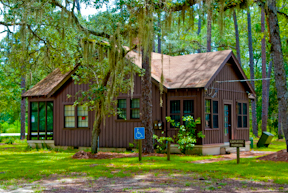Heritage Management
 The Ocala National Forest is a unique tapestry of interwoven ecosystems. From a central sandhill ridge, east and west to the lowlands of the St. Johns and Oklawaha rivers there exists five main ecosystems: sand pine scrub, longleaf pine sandhills, lakes/ponds/prairies, pine flatwoods and riverine hardwoods.
The Ocala National Forest is a unique tapestry of interwoven ecosystems. From a central sandhill ridge, east and west to the lowlands of the St. Johns and Oklawaha rivers there exists five main ecosystems: sand pine scrub, longleaf pine sandhills, lakes/ponds/prairies, pine flatwoods and riverine hardwoods.
Just as these ecosystems provide homes for a wide variety of natural flora and fauna, they have also been home to a species of cultural animal, Homo sapiens. Our kindred have left an unwritten record of their cultural activities in the sands of the Ocala. This record stretches nearly 10,000 years into the past, from present day to the earliest Paleo-Indian hunter-gathering camps on our crystal clear springs. Each succeeding culture has left a unique trail of material objects, know as artifacts, in its wake…broken pieces of pottery, arrowheads and flint flakes, hand-made iron nails, iron barrel hoops, bones of butchered food animals, ceramic turpentine collection cups, etc… Click to see the Cultural Timeline of the Ocala National Forest.
From these materials and their distribution, we can identify the hunting and gathering camps, village sites, transportation routes, food preferences and general environmental exploitation patterns of humans on the Ocala through time. We refer to this body of materials and information as the “heritage resource base” of the Ocala National Forest.
Unlike the Ocala’s renewable natural resources, such as trees, plants, and animals, its heritage resources are non-renewable. Each succeeding culture leaves a finite amount of material clues that enable future generations to interpret past activities. The loss of these cultural clues through time occurs as a result of two main processes: natural and human. Natural processes include erosion, oxidation, bacterial degradation and weathering. Human processes include intentional destruction, like vandalism and looting; and unintentional, like secondary effects from development activities.
Heritage management entails the location and identification of these sites, their protection, and their interpretation. There is little we can do to halt the natural ravages of time, with the exception of watershed erosion control. However, human destruction - intentional and unintentional - can be controlled.
Heritage management is a relatively new arm of the US Forest Service land management team. It is an outgrowth of federal environmental legislation passed in the 1970s and 1980s. Heritage Management is incorporated in every management decision involving any land-disturbing activity within the National Forest System.
Except for sites that occur in major recreation areas, the Forest Service does not publish the exact locations of its heritage resource sites. This measure is meant to prevent the intentional vandalism and looting of these resources. The use of metal detectors is strictly prohibited on the Ocala National Forest.
It is illegal to “dig, remove, injure or destroy any historic or prehistoric objects, ruins or sites” on federal land. “Violators subject to arrest, a maximum fine of $20,000.00, and or imprisonment.”
The Antiquities Act of 1906 and Archeological Resources Protection Act of 1979.
Heritage resource exhibits can be enjoyed at the Pittman Visitor Center, Davenport, Pat’s Island, Alexander Springs, Salt Springs, and Silver Glen Springs.

